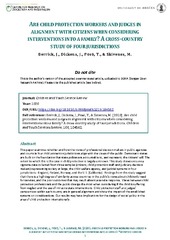Are child protection workers and judges in alignment with citizens when considering interventions into a family? A cross-country study of four jurisdictions
Peer reviewed, Journal article
Accepted version
Permanent lenke
https://hdl.handle.net/1956/22543Utgivelsesdato
2020Metadata
Vis full innførselSamlinger
- Department of Government [443]
Originalversjon
Children and youth services review. 2020, 108, 104562. https://doi.org/10.1016/j.childyouth.2019.104562Sammendrag
This paper examines whether and how the views of professional decision makers in public agencies and courts in four child protection jurisdictions align with the views of the public. Democratic states are built on the foundation that state polices are accountable to, and represent, the citizens’ will. The extent to which this is the case in child protection is largely unknown. This study draws on survey vignette data collected from three samples (citizens, child protection staff and judiciary decision makers) representing society at large, the child welfare agency, and judicial systems in four jurisdictions - England, Finland, Norway, and the U.S. (California). Findings from this study suggest that there is a high degree of similarity across countries in the public’s views about children’s need for services, and the poor outcomes that may result absent a service response. Views between child protection professionals and the public diverge the most when considering if the child is suffering from neglect and the use of intrusive state interventions. Child protection staff and judges’ perspectives within each country are in general alignment and show the impact of the established systems on considerations. Our results may have implications for the design of social policy in the area of child protection internationally.
